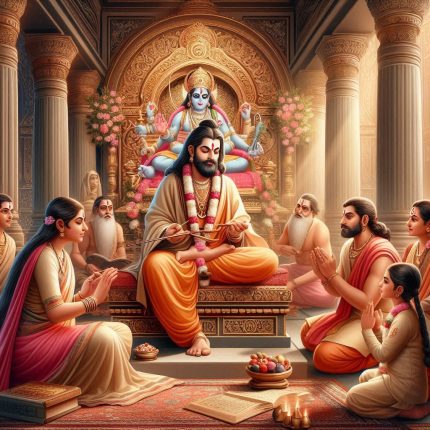Samagri
for Puja:
Haldi [organic] (20gm), Kumkum [organic] (20gm), Tulsi Mala (1), Diya Batti (5), Beetle Nuts (5), Desi Ghee (20ml), Honey (20ml), Jaggery (Gudh) (20gm), Akshata [Yellow rice] (20gm), Yagno-paveetha (5), Karpoora [camphor] (5Tabs), Red/White/Yellow Cloth(1 mtr), Prasad [Laung, Elaichi, Mishri] (20gm), Mouli (25mtr), Ganga Jal (15ml), Durva [fresh] (1), Agarbatti (6)/Dhoop (2), Dakshina (100INR), God Idols (pair), Sambrani (2), Sambrani Holder (1), Kalash [small copper] (1), Panchpatra [small copper] (1), Diya Holder (2), Panchamrit spoon (1), Karpoora Holder(1), includes perishables [Beetle Leaves [fresh] (9), Flowers [fresh] (incl mala), Tulsi [fresh], Mango Leaves [fresh] (7)]
Small Havan:
Cow Dung Cake (2), Mango Wood (250gm), HavanSamagri [20+ Grganic Herbs] (100gm), Ghee (20ml)
Yajman to provide:
Curd (100gm), Milk (100ml), Mithai (250gm), Fruits [5types], Coconut (1), HavanKund, SuchiSarva (Havan Spoon) (1), Kalash [big] (1), Bowl [preferably copper/silver] (1), Spoon [preferably copper/silver] (1), Utensils [2 big Plates (for Aarti/Samagri), disposable Plates, Bowls & Spoons], First solid food (preferably Kheer or Payasam)
Importance and Significance of Maha Mritunjaya Jaap
The Maha Mritunjaya Mantra, often referred to as the “Mantra of Triumph over Death,” holds profound significance in Hinduism. It is believed to invoke divine grace and protection against ailments, fear, and negativity. Engaging in this jaap is not only a means of seeking healing for oneself and loved ones but also a way to cultivate inner peace and resilience. The practice symbolizes surrender to the divine will, reinforcing faith and devotion.
Benefits of Maha Mritunjaya Jaap
- Healing Energies: The mantra is believed to have powerful healing vibrations that can aid in physical recovery from illnesses.
- Mental Clarity: Regular recitation enhances focus, clarity, and emotional stability, promoting a calm mind.
- Protection from Negativity: The jaap serves as a protective shield, warding off negative energies and influences.
- Spiritual Upliftment: Engaging in the jaap deepens spiritual awareness and connection, fostering a sense of oneness with the divine.
Occasions to Perform Maha Mritunjaya Jaap
The Maha Mritunjaya Jaap can be performed during significant life events, religious festivals, or when seeking healing and protection for oneself or loved ones. It is particularly beneficial during times of crisis or distress, providing comfort and reassurance.
Maha Mritunjaya Jaap Vidhi (Procedure)
- Preparation: Participants should dress in clean, traditional attire to symbolize respect for the sacred ritual.
- Setup: A sacred space is arranged with an altar featuring an idol or image of Lord Shiva, along with offerings such as flowers, fruits, and incense.
- Invocation: The ceremony begins with the invocation of Lord Ganesha to remove obstacles and ensure a smooth jaap.
- Commencement of Jaap: The recitation of the Maha Mritunjaya Mantra begins, ideally led by a knowledgeable devotee or a group, with deep focus and devotion. The mantra is typically recited 108 times or more, often using a mala (rosary) to keep count.
- Offering Prayers: Throughout the jaap, participants offer prayers for health, protection, and well-being for themselves and others.
- Aarti (Waving of Lights): After completing the jaap, aarti is performed to honor Lord Shiva, expressing gratitude and devotion.
- Blessings: Participants seek blessings from elders and spiritual guides present, receiving their good wishes for health and prosperity.
- Prasad Distribution: The ritual concludes with the distribution of prasad (blessed food), symbolizing shared blessings and gratitude.
Maha Mritunjaya Jaap Shubh Muhurat
Choosing an auspicious time for the Maha Mritunjaya Jaap is important to maximize its spiritual benefits. Consulting with an astrologer can help identify favourable timings based on the Hindu calendar.
By engaging in the Maha Mritunjaya Jaap, individuals and families invoke the blessings of Lord Shiva, inviting healing, protection, and spiritual growth into their lives. This profound practice serves as a powerful means of fostering faith, resilience, and a deep connection with the divine.




